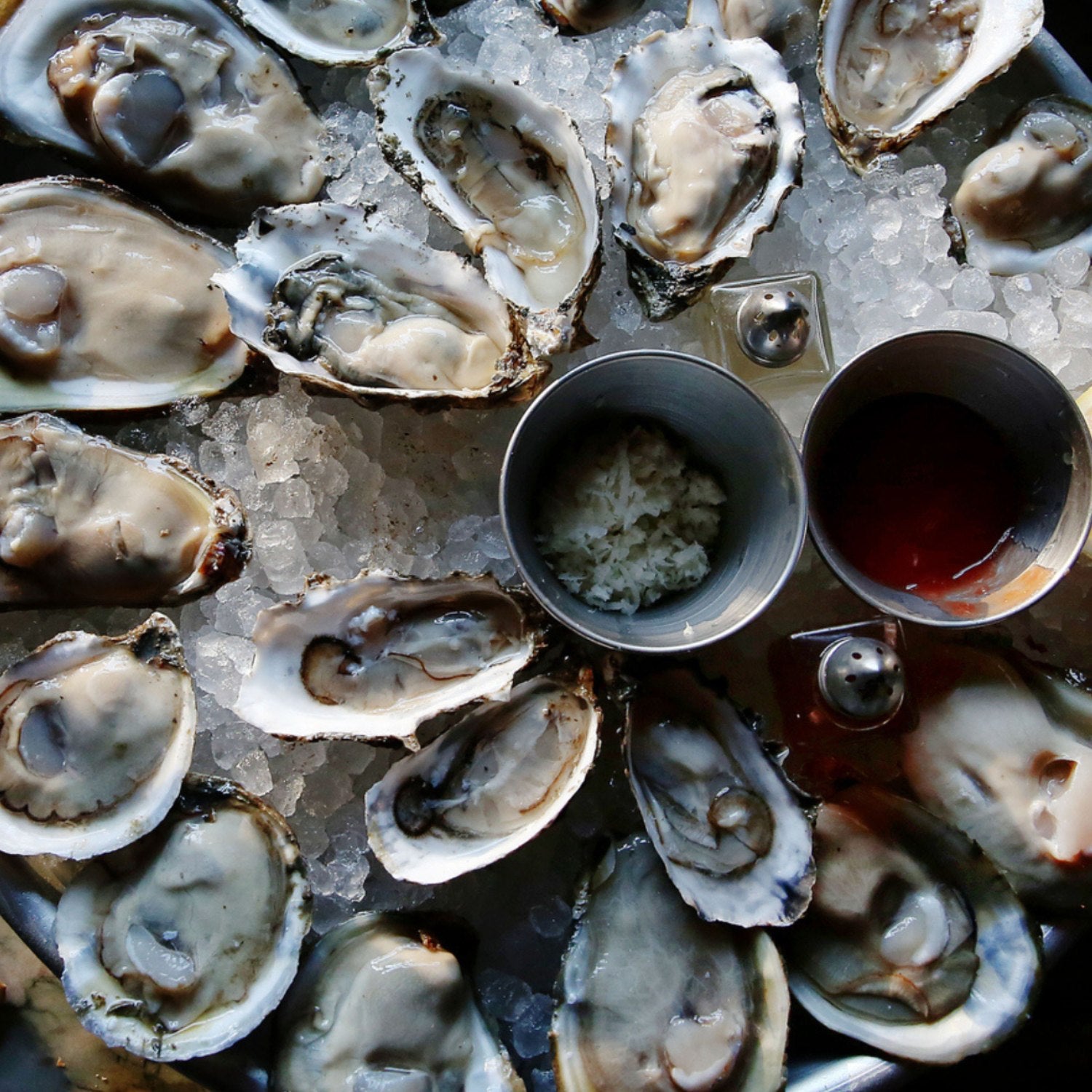On a brisk January morning, my family and I drove down to Duxbury, Massachusetts, where ’ on-site experience coordinator Karla Murphy gave us a tour of the company’s hatchery. We tracked the life cycle of an oyster; in the middle of winter, the iconic Massachusetts seafood purveyor was simulating summer. Full-sized oysters, taken from Duxbury Bay right outside the hatchery’s window, sat in temperate water, waiting to spawn, at which point a laborious process of reproductive magic would occur.
Walking through the rooms of what felt like a science museum, we peered through beakers of brightly colored liquid, a spectrum of algae in a kaleidoscope of brown, kelly green, and red. Island Creek’s job is not only to breed and sell oysters, but also to study their environment, which is why the company knows, for instance, that a winter oyster, plucked from the bay’s cold, briny water, tastes different than a summer one.
What’s The Best Season for Oysters?
If oysters are now associated with summer— kicking back on a balmy summer evening with a dozen fresh ones on the gorgeous deck at Glidden Point Oyster Farms in Edgecomb, Maine, say, overlooking the Damariscotta River—perhaps we’ve moved a little far from the old adage that used to define oyster-eating. That’s the one that instructed oyster-lovers to eat oysters only in months that contain the letter “r.” We have refrigeration now, after all.��
Still, it’s worth considering the oyster, in 2023, as a both year-round delight or and a food that can be enjoyed more resolutely in winter than in summer. Like agricultural products, the taste of which reflects where they grow and the soil in which they are grown, oysters, which are filter-feeders, deeply reflect their environment.��
“For many years now, people have been using the term merroir,” says Evan Mallett, chef and owner of in Portsmouth, New Hampshire, and former owner of Ondine Oyster + Wine Bar in Belfast, Maine. “The difference in microclimate can actually take place in the same part of the same river, depending on how and at what elevation in the water that oyster was raised.” Mallet contrasts this with the wine term often used to describe the same quality: terroir.��
“I think the best example of this is from two of the most famous American oyster appellations—Island Creek and Wellfleet, which are only 17 miles apart,” says Chris Sherman, CEO, Island Creek Oysters. “Much like legendary areas of, say, Napa Valley in the wine world, they are close, but there are vastly different environmental factors.” Sherman cites tides, breezes, freshwater inputs, bottom substrates, and even farmer intervention, all of which can create a dramatically different tasting oyster.��

Oysters are not only impacted by where they grow; their flavors are affected by when we eat them, and there’s a good argument to be made for doing so in the colder months. “Oysters eat cleaner and taste better in the winter,” Evan Mallett says. That’s because lower water temperatures can cause many varieties of algae to die off, changing the food availability for the bivalve and forcing it to rely on stored glycogen for survival.In shorthand, the oyster fattens up, filtering mostly water and whatever else it can find in colder waters. This is particularly true up north, in areas like Massachusetts, Maine, and Nova Scotia.��
Oysters, adds Ryan McPherson, owner and president of the aforementioned , taste different at every time of the year and are particularly rich when they are preparing for the long, cold winter. “It’s that fatty buildup that happens at the end of the year, going into the colder months,” McPherson says, specifically of cold-weather oysters. “They plump up and they put on this fat.” That fat, he says, can often hold salt, making winter oysters richer and brinier than their summer counterparts.��
How to Eat Oysters
As for how to eat an oyster in winter, well, it’s time to let the imagination run wild. My own winter has been filled with bivalves. One night, at , in Lynn, Massachusetts, I enjoyed a Kusshi, a cultivated species from an oyster farm in Deep Bay, British Columbia. The oyster had a deep pocket from a good tumble in Pacific waters, and its cup held a firm, briny, and fatty oyster (I’m not sure a summer version could have held up as well to the hackleback caviar, strips of preserved lemon, and black truffle mignonette that came on top).��
I could imagine tucking a puck of butter and a sprinkling of smoked salt into a sextet of Kusshis and tossing them onto the grill for just a few minutes until they cooked through—warmed but not chewy—and slipped onto a piece of crisp bread like escargots with the butter and brine infused as one.��
The opportunities for creativity with winter oysters, says Daniel Sabia, creative director and owner of , in Hudson, New York, are endless. “We’ve done everything from cold-smoking oysters and serving them with their classic pairings to serving perfect ice-cold oysters with the following sides: burnt harissa cocktail sauce, charred corn and burnt scallion mignonette, cold-smoked oyster aioli cut with tangerine juice, and charred pepper vinegar,” he says. “It’s truly a fun dance of flavor and technique.”
If you prefer a warm oyster cooked over wood fire, refrain from cooking them over direct heat. “Oysters are so fragile and delicate,” Sabia says. “We still use red-hot coals and let the shell do all the work by retaining the heat and keeping all the liquid in the shell from drying out.” Pacific Coast varieties, like the Baynes Sound oyster, from British Columbia, is a large and toothsome bivalve that can hold up to pan roasts, wood-fired grilling, and cold-smoking.��
As our hatchery tour at Island Creek wound to a close, Karla Murphy escorted us to brunch at The Windsor House, where she had set up a true oyster tasting for us. There, Island Creek owner and oyster farmer Skip Bennett’s prizes were on full display: four Island Creeks from Duxbury Bayand and four Tumblecans from Saquish Neck, which were tumbled oysters deep in the pocket with a robust, briny meat.��
We also ate four tiny Aunt Dottys, named after Bennett’s own aunt, also from Saquish. They were salty and meaty, with an intense and powerful finish. Hungry for our bivalves in their natural, winter state, we ate these plain, then accented with a trio of caviar from the hatchery’s impeccable stores, then with an eyedropper of mignonette, until, sadly, they were gone. Winter always feels long but with more oysters on the menu, it now feels far less interminable.


